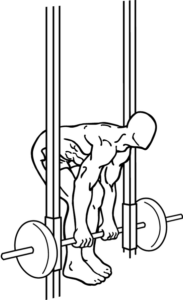What exactly is the rack pull and its benefits?
Rack pulls can do several great things for your body — male or female.
One of its biggest benefits is that it will help you get past plateaus.
What is a Rack Pull?
It’s a variation of the deadlift. Instead of the bottom portion of the movement being on the floor (barbell on floor or touch-and-go to the floor), the bottom is on the bars of a squat rack that are set between knee height (or sometimes even a bit lower) and about mid-thigh height.
This allows one to pull a lot more weight than with the standard floor deadlift.
This style is not to be confused with shoulder shrugging, even though when the bars are set at mid-thigh level, the movement may initially appear to be a form of shoulder shrugging.
The shoulders do not shrug in the rack pull. In fact, if one is able to shrug the shoulders during this exercise, the weight is not heavy enough if you want to create a bullet-proof back and improve your regular deadlift.

Starting position for a rack pull. Feet should have athletic wear and should be apart. How apart depends on personal preference. Some people space them as they would for a deadlift. Everkinetic, Creative Commons
The primary purpose of the rack pull is to move as much weight as possible, and the limited range of motion — in combination with many major muscle groups getting involved — allows this to happen.
Lifting as much weight as possible is accomplished only when one applies nothing more than the pure deadlift motion — with the adjustment of the bottom portion of the exercise being higher than the floor.

What muscles does the rack pull work?
The rack pull works the same muscle groups as the conventional deadlift, though there is less force absorbed by the legs, since the exerciser doesn’t lower their body as much.
Nevertheless, the legs still get worked with this movement. And I’m talking here about the bent-leg version, which allows you to move more weight than if you were to keep your legs straight.
Rack Pull Benefits
This style of training will contribute to building muscle because it permits one to lift so much more weight.
The higher that the catch bars are set, the more weight that a person can strain and lift with, providing a unique stimulation to the muscle fibers.
The back muscles really get involved, and the fibers will respond accordingly.
The arms, too, take a good beating during a 6-10 rep max of rack pulls. Nobody with scrawny arms is going to rack pull enormous loads.
However, one must have a pretty good grip to get through a blasting set of rack pulls; it would be a shame if one has to quit the set because the wrists and forearms fatigue before the major muscles do.
Some people will perform rack pulls with the bars set literally only several inches from the floor.
This still seems to be more of a pure deadlift than a rack pull, but nevertheless, it allows a person to move more weight.
The exercise can also be done simply as an exercise in and of itself, regardless whether or not one is stuck at any kind of plateau.
It truly is a great exercise and gets the body used to moving tremendous amounts of weight, relative to what it can move with other exercises.
Any person who wants to get huge should include rack pulls–and work towards pulling the most beastly weight possible.
In fact, anybody who can perform rack pulls with insane amounts of weight is always huge. It goes with the territory.
To achieve this goal with the rack pull, one needs to perform it properly.
How to Do Rack Pulls
• One’s standard deadlift form should be mastered first.
• Set the catch bars of a squat rack station to some point between the knees and mid-thigh, maybe even a little bit below the knees, depending on a person’s preference for range of motion.
• Load the barbell with more weight than what one normally does reps with for a standard deadlift.
This will require some experimentation because often, a person who is new to rack pulls won’t put on enough weight, or, the opposite will happen:
They will load the barbell with too much weight, overestimating how much they can lift.
• It won’t be long before a person figures out the appropriate load for a given height off the floor.
• Position the body in a way that makes you feel that you can lift safely and progress with heavier weights. Often this positioning is similar to a person’s usual deadlift.
• Range of motion at the top of the lift is supposed to be as complete as in a regular deadlift.
• Because most people want to move as much weight as possible with the rack pull, the load is usually too heavy for the touch-and-go style at the bottom of the movement.
In the touch-and-go style of the regular deadlift, the barbell plates very briefly tap the floor before the trainee pulls the weight back up.
When the load is enormous (relative to the person, of course) in the rack pull, the individual is forced to solidly set the barbell on the catch bars before lifting it back up again.
In fact, the load may be so heavy that the trainee must readjust their hands between each lift.
Sometimes there is a two-second rest in between repetitions. The idea behind the rack pull, as already pointed out, is to move as much of a load as possible.
In other words, there’s really no point in doing this with weight light enough to just bounce through the repetitions.
Form for the rack pull must be perfect to prevent injuries. Even if the bottom movement stops at mid-thigh, injury can still result if not careful.
One must not let the limited range of motion fool them into thinking that injury is not possible.
 Lorra Garrick is a former personal trainer certified through the American Council on Exercise. At Bally Total Fitness she trained women and men of all ages for fat loss, muscle building, fitness and improved health.
Lorra Garrick is a former personal trainer certified through the American Council on Exercise. At Bally Total Fitness she trained women and men of all ages for fat loss, muscle building, fitness and improved health.
.









































